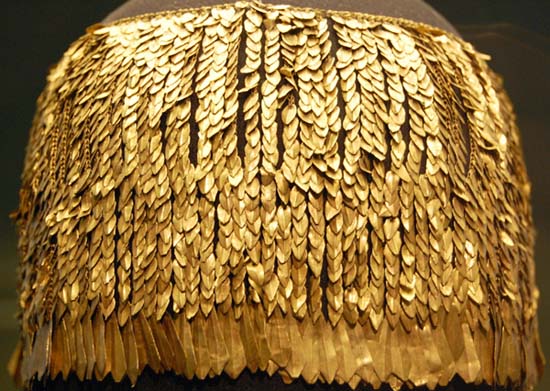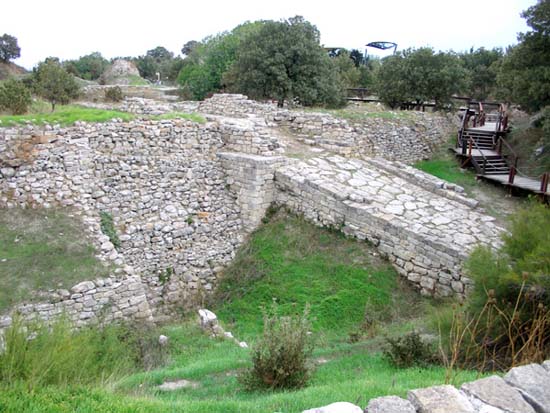Homer’s Iliad, Troy and the historicity of myth
2.6 The Trojan War: myth or ‘damaged history’

‘The Jewels of Helen’, Pushkin Museum, Moscow
© S.P. Kershaw

The ramp at Troy II
© S.P. Kershaw
Food for thought: The treasure was found close to the ramp. Heinrich Schliemann’s wife, Sophia, was famously pictured wearing them in an iconic nineteenth-century photograph. How likely are they to be ‘the jewels of Helen’?
One way of seeing hidden meanings in the myths that is perhaps rather mundane, but which has a pedigree that stretches right back into antiquity, is that they are distorted versions of real events.
Greeks of the classical period regarded the Trojan War as a genuine historical occurrence, and Homer’s Troy came to be identified with a smallish hill, 6 km east of the Aegean coast and 4.5 km south of the Dardanelles, on which a citadel had stood. In Ottoman times this came to be known as Hisarlık (‘furnished with a citadel’). The man most associated with the modern quest for Homer’s Troy was Heinrich Schliemann (1822–1890), whose amazing finds at Hisarlık – including the so-called ‘Treasure of Priam’, which is now mostly in the Pushkin Museum in Moscow – seemed to confirm his theory that it was indeed Priam’s Troy.
American archaeologists from the University of Cincinnati subsequently excavated in the 1930s under the direction of Carl Blegen, who too was very much a ‘Homerist’:
It can no longer be doubted […] that there really was an actual historical Trojan War, in which a coalition of Achaeans, or Mycenaeans, under a king whose overlordship was recognized, fought against the people of Troy and their allies.
The current excavations have been running since 1988 under an international team, initially directed by Manfred Korfmann from the University of Tübingen, and currently by Professor Rüstem Aslan from Çanakkale Onsekiz Mart University in Turkey. This ‘Troia Projekt’ is a multidisciplinary venture with state and private funding, but it has generated considerable controversy and criticism: Korfmann believed that Homeric tradition reflects a specific historical event, but it was in his interests to do so in the popular, if not the academic, press, since the Trojan War is ‘sexy’ and helped his quest for funding.
So, how much history is there in the Trojan mythology?
Individual activity: A video tour of Hisarlık/Troy
© S.P. Kershaw
Group activity: The Trojan War
Read Kershaw pp. 317–19 and Korfmann, M., 2004 ‘Was There a Trojan War?’, Archaeology, vol. 57, no. 3, May/June. You might like to check out The Oxford Classical Dictionary, s.v. Troy.
On the Iliad forum, discuss the likelihood that the Trojan War actually happened.